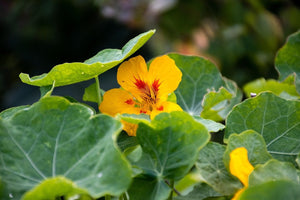Liatris from Seed: How to Grow and Care for Blazing Star Flowers
LiatrisLooking for a unique wildflower that’s low-maintenance and an incredible pollinator magnet? Add Liatris/Blazing Star to your flower garden. Its vibrant spikes of purple, pink, or white blooms create a beautiful visual impact and attract butterflies, bees, and hummingbirds. We’ll give you all the tips you need to successfully grow Liatris from seed.

What is Liatris
Liatris, commonly known as Blazing Star or Gayfeather, is a striking perennial wildflower native to North America. Known for its tall, slender spikes of vibrant purple, pink, or white flowers, Liatris stands out in gardens for its unique vertical growth and feathery flower heads. The blooms open from the top down—a rare trait among flowering plants—creating a long-lasting display of color throughout the summer and into early fall. Aside from its ornamental appeal, Liatris is a magnet for pollinators, attracting butterflies, bees, and even hummingbirds. This hardy plant is drought-tolerant, thrives in full sun, and is well-suited for garden beds, borders, and naturalized areas.
How to Grow Liatris From Seed
Growing Liatris from seed is an economical way to create a large patch of flowers. Once they’re blooming, you’ll have a daily show of bees, butterflies, and hummingbirds in your garden.
Fool-proof Liatris Seed Germination Tips
- Liatris seeds need to be cold-stratified before they will germinate. You can do this naturally by planting seeds in the fall or cold-stratifying seeds indoors.
- If you want to plant your seeds directly into the garden, plant in late fall or early winter. This will give the seeds a natural cold period so that they will sprout in spring.
- You can also start Liatris seeds indoors. When starting seeds indoors, cold stratify the seeds in the fridge. Our instructions and video will show you exactly how to do this. You will need to keep the seeds cold for 4 to 6 weeks before planting indoors.
- To plant liatris, press seeds firmly into the soil to ensure good contact. Liatris seeds should not be planted deeply, so leave them on top of the soil or just lightly cover them with soil.
- Indoor-started seeds need to stay moist with a temperature of 60-70ºF.
- Keep grow lights close to the Liatris seedlings to keep them from becoming leggy. Once they are several inches high, they can be hardened off for transplanting outdoors.
- Transplant Liatris seedlings outdoors into moderately fertile, moist, well-drained soil after seedlings reach several inches high. Space liatris seedlings 12 inches apart.
- Divide root clumps every 2-3 years in late winter or early spring when the plants are still dormant.

Caring for Liatris - Blazing Star Plants
Liatris is a low-maintenance perennial. Once you plant it in a wildflower or cottage garden, it will be a reliable bloomer year after year. With its bottle brush shape and purple color, Liatris makes a beautiful display with yellow flowers such as Coreopsis. They also look nice next to Lamb’s Ear.

Sun
Full sun is recommended for growing this native wildflower. Although liatris can tolerate partial shade, full sun will give you the most blooms.
Soil
Liatris plants prefer poor soil and will grow stronger stalks as a result. In overly rich soil, the flower stalks will be floppy. The soil needs to drain well to avoid crown and root rot. Liatris also prefers slightly acidic soil.
Water
Water only when the soil is dry. Liatris is a plant that can tolerate drought once it has well-established roots. For seedlings and young plants, keep the soil moist but not waterlogged.
Fertilizer
Too much of a good thing makes liatris plants more frail. A rich supply of nutrients can result in weak stalks that don’t hold up the weight of those fluffy flowers. So don’t apply fertilizer during the growing season.

Harvesting/Pruning
Liatris flowers started from seed can take two years to bloom. Once the roots are established, the plant will begin blooming. Liatris flowers bloom from July into autumn. The buds on the top of the stalk open first and progress to the bottom.
Cutting the stalks for flower arrangements can actually encourage new growth as long as there is still time in the growing season. A good time to cut liatris is when about 2/3 of the blooms have opened. They can be used fresh, or they can be hung upside down to dry.
At the end of the season, you can cut blooms off at the base of the plant. You can also leave the seed-covered stalks to feed the birds.
Overwintering
Liatris is hardy in USDA zones 5 to 8. In these zones, you can leave the plants in the ground over winter. You can dig up the corms in colder zones and store them in a cool place for at least 10 weeks. This replicates the natural cold period they need before they start growing again.

Pests & Diseases
Liatris have few problems with pests or diseases. However, rabbits like to eat them when they are young and tender. Underground pests such as voles may also eat the corms.
Possible diseases are powdery mildew, verticillium wilt, and leaf spot. Keep plants spaced far apart for good airflow to help avoid these problems.
Crown and root rot are problems that can be avoided by planting liatris in soil that drains well.

Liatris FAQs
Does Liatris spread?
Liatris can slowly spread through corms underground. It is not considered invasive or aggressive since the growth is slow. Corms can be divided every few years.
Where is the best place to plant Liatris?
The best place to plant liatris is in moderately fertile soil in full sun.
Is Liatris drought tolerant?
Liatris can withstand dry conditions and requires infrequent watering once it is established.
When and how should I divide Liatris?
Since Liatris is a perennial, it can be divided every few years. Dig up the corms in late winter or early spring while the plant is still dormant. Break them apart to plant in other areas and give them enough room to grow. Usually 12 to 18 inches apart.
What month do you plant Liatris?
When growing liatris from seed, you can cold stratify the seeds indoors any time of year. You can also plant seeds in the late fall so they can naturally stratify over winter.
Planting liatris corms can be done in late winter or early spring while the plant is still dormant.
Do liatris flowers come back every year?
Liatris, or Blazing Star, is a perennial that will come back year after year as long as the corms and roots stay healthy.
Should you deadhead Liatris?
Deadheading or cutting off the flowers before they go completely to seed will encourage more flowers to grow. At the end of the season, you can leave the stalks for birds to eat the seeds or cut the stalks at ground level.
Growing Liatris from seed is a rewarding process that adds a touch of wild, natural beauty to your landscape, and once established, it’s incredibly low-maintenance and drought-tolerant.
You’ll be amazed at how well Liatris attracts pollinators like butterflies and bees! If you’re aiming to create a vibrant, wildlife-friendly garden with minimal effort, Liatris is a perfect pick!
Ready to start growing your own Liatris? Purchase high-quality, heirloom Liatris seeds from Sow Right Seeds today and enjoy the beauty and benefits of this remarkable flower in your garden!
Popular Posts
-

Best Friend in the Garden and Edible Flower: How to Grow Nasturtium From Seed
-

Top 10 Easiest Vegetables to Grow from Seed






Leave a comment